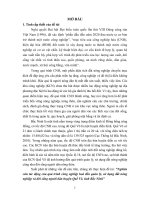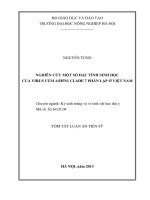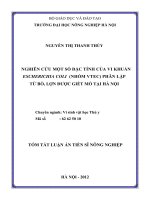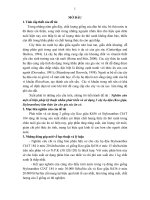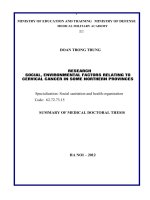tóm tắt luận án tiếng anh nghiên cứu một số yếu tố môi trường xã hội liên quan tới ung thư cổ tử cung tại một số tỉnh phía bắc
Bạn đang xem bản rút gọn của tài liệu. Xem và tải ngay bản đầy đủ của tài liệu tại đây (269.15 KB, 30 trang )
1
MINISTRY OF EDUCATION AND TRAINING MINISTRY OF DEFENSE
Medical military academy
DOAN TRONG TRUNG
RESEARCH
SOCIAL, ENVIRONMENTal FACTORS RELATING TO
CERVICAL CANCER IN SOME NORTHErN PROVINCES
Specialization: Social sanitation and health organization
Code: 62.72.73.15
SUMMARY OF MEDICAL DOCTORAL THESIS
HA NOI – 2012
2
THE THESIS WAS COMPLETED:
Technical Supervisor:
1. Prof PhD. LUONG XUAN HIEN
2. Prof PhD. LE KHAC DUC
REVIEWER 1: Prof PhD. DANG DUC PHU
REVIEWER 2: Prof PhD. NGUYEN DUC VY
REVIEWER 3: Prof PhD. NGUYEN THI THU
This project will be defended at Doctoral Thesis Scoring Council
at Medical Military Academy
At: 8h30, 18 - 4 - 2012
The thesis can be found at:
- National Library
- Library of Medical Military Academy
- Medical Information Library
3
RELATED PUBLISHED PROJECTS OF THE AUTHOR
1. Doan Trong Trung, Tran Van Thuan, Nguyen Phi Hung
(2009), “Situation of cervical cancer, cervical body cancer of
patients visiting K hospital in Hanoi from 2001-2006”,
Practical Medical Magazine, Vol 6 (665), page. 120-121.
2. Doan Trong Trung (2010), “Finding correlation among
some social, environmental factors, health and cervical cancer
of women in 12 provinces of Vietnam”, Practical Medical
Magazine, Vol. 11 (741), pg. 86-87.
3. Doan Trong Trung, Luong Xuan Hien (2010), “Finding
impacts of some reproductive factors to rate of cervical
cancer of northern women in”, Practical Medical Magazine,
Vol 12 (745), page. 48-50.
BACKGROUND
4
According to the World Health Organization’s predict for the
disease model of the 21st century, non-infectious diseases, including
cancer, is a major disease group that threats human health. Cervical
cancer is the cancer with a high mortality rate in women after breast
cancer, especially in developing countries, including Vietnam. It is
one of the challenges in health care for women at health facilities and
in the community.
In Vietnam, women are still a very important force in the
structure of the labor force, the majority of the working conditions is
affected adversely and hard. Besides, large proportion of women is
currently using family planning measures such as IUD, pills, tubal
ligation sterilization and Quinacrine placed into the chamber uterus.
Therefore, one of the problems associated with cervical cancer
is paid attention is whether the social, environmental factors have an
impact on the increase the incidence of cervical cancer among
Vietnamese women. To 2001, the period before the implementation
of the thesis, there is no deep research analyzing model of cervical
cancer in Vietnamese women and the relevant factors including the
sterilization by Quinacrine. Only a few studies have focused on the
recognition of cervical cancer in the hospitals, or conduct research
screening cervical precancer of community in narrow areas.
Therefore, we conduct the topic "Research some social,
environmental factors related to cervical cancer in some northern
provinces" to respond above demands.
OBJECTIVES
5
1) Describe the current situation of cervical cancer in 12
northern provinces in Vietnam, 2001-2006.
2) Identify some social, environmental factors related to
cervical cancer in research area.
PRACTICAL MEANING AND NEW CONTRIBUTION
OF THE PROJECT
The topic is urgent, practical, helping the health sector has new
discoveries about the characteristics of cervical cancer, an
association between cervical cancer and some factors which have not
been previously researched or insufficiently researched in Vietnam
in general and 12 mentioned provinces in particular.
The research results will be the scientific basis for policy
makers to develop policies, build up appropriate interventions and
proper health communication to prevent cervical cancer in the
community. This will contribute to improving the quality of health
care services for population in general and for women in particular.
The research results are also a scientific basis for clinical medical
staff to take as reference and put into applications in improving the
quality of care and treatment of cervical cancer.
STRUCTURE OF THE THESIS
The thesis consists of 116 pages (not including the table of
contents, list, references and appendices), including 4 chapters:
Chapter 1: Review documents, 32 pages, Chapter 2: Subjects and
Methods, 20 pages, Chapter 3: Research results, 28 pages, Chapter 4:
Discussion, 30 pages. The thesis has 34 tables, 11 charts, 2 figures
and 2 diagrams. 140 References: 55 Vietnamese documents and 85
English ones.
CHAPTER 1
6
REVIEW DOCUMENTS
Every year there are estimatedly 471,000 cases of cervical
cancer (CC) being newly diagnosed in the world, of which there are
about 380,000 new cases in developing countries, with more than
273,000 deaths. In Vietnam, CC is the second most common cancer
in women, however, the incidence is very close to the incidence of
breast cancer. The incidence of CC in Ho Chi Minh City is specific
to high-risk populations in the region, but 4 times higher than that in
Hanoi. The incidence of CC in Hanoi is close to the low-risk
populations. This is more noticeable as the number of cancer patients
in Vietnam are in the trend of increasing, there are about 120,000
people with cancer were detected, of which half of them are on the
last stage of the disease.
The study of Hirohiko Tsujii noted that common age of CC is in
the 50-59 range. Dang Thi Phuong Loan author also noted the
common age range is 40-49, mean age is 52 and another study of Le
Phuc Thinh in Ho Chi Minh City found common age for cervical
cancer is 40-50 years old. In the correlation between CC and
occupation, we find that women who are farmers accounted for the
highest percentage of 53.6% CC. The study of Coker Al showed that
women with CC and smoking at the detecting time had higher risk of
death by this disease than other women. In addition, women who do
not have health insurance or themselves pay for medical care are at
higher risk of death from the disease.
According to research by Martinez, early sexual intercourse is
one of the factors that increases the risk of HPV infection. It was
found that cervical cancer related to external factors such as multiple
births, many abortions, STIs. The incidence of disease is detected at
high levels in women of child marriage and early birth giving,
7
multiple births. Specifically, prostitutes, over 3 time married women
and women with ulcer in cervix have 7 times higher risk of getting
cancer than normal ones.
Quinacrine has been used as a contraceptive method in many
countries around the world. This method was first applied in Chile
and subsequently replicated in many countries, including Vietnam.
In Vietnam, the sterilization program for women of childbearing age
by Quinacrine has been done since 1989. By late 1993, the program
was stopped to reassess after receiving a letter from the World
Health Organization mentioned that Quinacrine can cause
gynecological cancer for users. So far this sterilization method has
not yet to be carried out again due to the above concern.
Worldwide, there have been some researches to find out the
correlation of Quinacrine with gynecological cancer issues. One of
them was the study of David C. Sokal (FHI) about the cancer risk for
women with Quinacrine sterilization in Chile by 1996. Although the
research have come up with the conclusion that there was no
possibility of Quinacrine causing cancer, but due to the sample size
of the study was not really big enough, the number of detected
cancer cases were small, so persuasiveness of the study was not
really high.
Although there have been many studies on cancer being
conducting in Vietnam, there are still no studies which is large
enough about gynecological cancers, especially cervical cancer. In
Vietnam, there is a lack of official researches on the common risk
factors associated with cervical cancer and does not have any official
studies on the relationship between cervical cancer with Quinacrine
sterilization in women.
8
CHAPTER 2
SUBJECTS AND METHODOLOGY
2.1. Time and Venue
The study was conducted in 12 northern provinces of Vietnam,
including Nghe An, Ninh Binh, Nam Dinh, Ha Nam, Thai Binh, Hai
Duong, Hung Yen, Ha Tay, Bac Giang, Bac Ninh, Vinh Phuc and
Phu Tho.
These provinces were selected on purpose. Selection criteria are
as follows:
- Provinces have provincial hospitals and / or provincial
maternity hospitals which can perform clinical examination, sub-
clinical examination, sampling, and fixed gynecologic cancerous
specimens meeting standards of the Ministry of Health .
- Provinces have hospitals which agreed to participate in the
research when invited after being selected.
Study period: 5 years: From 9/2001 - 8/2006
2.2. Subjects
Study subjects were women born in the period from 1947
through 1966. The subjects were divided into 2 groups: case and
control groups:
+ Case group: As all the women in the study age in 12
provinces, suffering from primary cervical cancer, found at selected
hospitals and identified through histological diagnosis or cytology.
+ Control group: Women without CC, randomly selected from
people who stay in the same villages or have same age group with
case group.
9
2.3. Research Methodology
* Research Design: case – control study, in which case groups
included women with primary cervical cancer and control groups
included women without cervical cancer who lived in the same
villages / hamlets and in the same age group with responding cases
* Sample size of case group:
Calculated as following:
n=Z
2
(1-α/2)
{1/[p
1
(1-p
1
)] +1/[p
2
(1-p
2
)]
[ln(1-€)]
2
In which: p
1
is percentage of individuals exposing to risk
factors estimated for case group; p
2
is percentage of individuals
exposing to risk factors estimated for control group; € is the level of
accuracy chosen by investigator;; Z
(1-α/2)
is reliability of the study
With reliability of 95%, Reliability coefficient is 1.96; we get
p
1
=0.047, p
2
=0.019; selecting €=0.5 so the sample size is 608 cases.
* Sample size of control group:
Control group is selected on purpose 3 times higher than case
group: 608 cases x 3 controls/case = 1824 controls.
* Selecting cases: Cases, who are living in 12 provinces, were
selected from 15 participant provincial hospitals and 12 national
hospitals in Hanoi. Case selection was stopped till the number of
case were over or equivalent to the sample size.
As result, 611 cases were selected and put into the research.
* Selecting controls: Each identified cervical cancer case will
have 3 controls which selected randomly from women who stay in
the same villages and have same age with cases.
Totally, there were 1833 individuals for control group.
10
* Exclusion criteria: Women who have moved away and no
longer live locally, unable to keep track. Women with mental
impairment, unable to understand and respond to the questions raised
during the interview. The women refused to participate in the study.
* Diagnostic criteria: The diagnosis of cancer to determine the
case was conducted by histopathological examination, it is required
to diagnose the cases. In some specific situation, due to lack of
biopsy specimens, clinical diagnosis and cytology diagnosis methods
can be used.
* Handling specimens and cervical cancer diagnosis:
specimens after biopsy, surgery were fixed in formal 10%,
transferring to Citadel-2000 of Shandon. The specimen is then dyed,
read the optical microscope by the pathologist doctor with
experience at K Hospital in Hanoi. The final decision was evaluated
by the Confirm Board. The board includes three prestigious
professors of anatomy and clinical.
* Research Contents:
- Status of cervical cancer: Distribution of cervical cancer cases
in the study area (12 provinces), the type of cancer. Characteristics
of cervical cancer object on demographics, health, the use of
contraceptives, living habits, lifestyle.
- The relationship of cervical cancer with the social and
environmental factors, including demographics, health, living and
lifestyle
* The variables in the research:
The variables used in the research were divided into two
groups: Independent (The elements can be related to cervical cancer)
and the dependent variable (cervical cancer):
11
The independent variables:
- Demographic and medical characteristics:
+ Age, education level, occupation, marital status…
+ The use of medical insurance card
+ Age of first pregnancy, number of living children, menstrual
status
+ Number of full-term pregnancy, stillbirth, miscarried,
abortion
+ Number of partner / husband
+ Vaginal enema, take specimens in the reproductive organs
+ Hormone therapy after menopause
+ infected STDs and some other diseases.
+ History of ovarian removal surgery
+ Apply contraception: IUDs, oral contraceptives (pill,
injection, Quinacrine sterilization)
- Living and lifestyle characteristics:
+ Tobacco smoking status of women
+ Tobacco smoking status of husband
Dependent variable:
The dependent variable in this study is defined as cervical
cancer in women in the research area.
* Data processing:
- Data were entered and processed using FoxPro for Windows
software version 2.5 and SPSS 13.0.
- The statistical parameters were calculated in the study:
+ Quantity, percentage, odds ratio (OR), confidence interval
(CI) 95%.
+ Univariate Analysis (using chi square test χ2 ).
+ The parameter in logistic regression analysis.
12
CHAPTER 3
RESEARCH FINDINGS
3.1. Status of cervical cancer
Chart 3.1. The age of women have cervical cancer (n=611)
The highest rate of cervical cancer is in women from 46-50 years
old (31.9%) and lowest among women 31-35 years old (0.3%)
Chart 3.2. The education level of women have cervical cancer
(n=611)
13
Most cases of cervical cancer are found in women with primary
education (15.7%) and secondary education (62.2%), and a small
percentage of illiterate women (1.6%).
Chart 3.3. The occupation of women have cervical cancer (n=611)
Most of cervical cancer cases occur in farmer women (61.2%),
lowest percentage in women who had been soldiers (0.3%), the
remainder mainly worked administrative or sale field.
Table 3.1. The type of cervical cancer is detected
Type of cancer cases Number Percentage
1. Squamous cell carcinoma non keratinizing 407 66.6
2. Adenocarcinoma of cervix 73 11.9
3. Endometrioid adeno carcinoma 29 4.7
4. Adeno squamous cell carcinoma 30 4.9
5. Squamous cell carcinoma keratinizing 8 1.3
6. Mucous adenocarcinoma 28 4.6
7. Carcinoma of small cells 13 2.1
8. Clear cells carcinoma 7 1.1
9. Squamous carcinoma of crystal cells 7 1.1
10. Other 9 1.5
Total 611 100.0
14
In some case of cervical cancer, Squamous cell carcinoma, non-
keratinizing account for the highest percentage (66.6%), other types
of cancer account for lower rates.
3.2. Factors associated with cervical cancer
Table 3.2. Association between education levels of women with cervical
cancer
Education level Cancer
No
cancer
OR
(95%CI)
p
1. Illiterate 10 15
0.46
(0.18-1.13)
>0.05
2. Primary level 96 327
1.04
(0.64-1.68)
>0.05
3. Secondary level 380 1099
0.88
(0.57-1.37)
>0.05
4. High school level 68 190
0.85
(0.51-1.41)
>0.05
5. Technical Intermediate
level
29 110
1.15
(0.64-2.08)
>0.05
6. College / university
level or higher
28 92 1 -
There was no statistical difference between the groups of women
with technical intermediate education level or less and women with
college / university, with (p> 0.05).
15
Table 3.3.
Association between
cigarette smoking
of women with cervical cancer
Cigarette
smoking
(>100 cigarettes)
Cancer
No
Cancer
OR
(95%CI)
p
Yes 8 17 1.42
(0.56-3.49)
>0.05
No 603 1816
Total 611 1833
There was no statistical difference in the rate of cervical cancer
among women who smoked more than 100 cigarettes in their whole
life compared to other groups.
Table 3.4.
Association between women have husband who
smoked
with
their cervical cancer
Cigarette smoking
(>100 cigarettes)
Cancer
No
Cancer
OR
(95%CI)
p
Yes
420 1038
1.68
(1.38-2.04)
<0.05
No
191 795
Total 611 1833
The women who have husband smoked more than 100 cigarettes
during cohabitation are at risk for cervical cancer 1.68 times higher
than the other women (p <0.05).
16
Table 3.5. Relationship between cervical cancer and smoke level of
their husband
The total number of
cigarettes smoked
Cance
r
No
Cancer
OR
(95%CI)
p
≥1000 cigarettes 300 520
2.49
(1.94- 3.20)
<0.05
<1000 cigarettes 120 518
Total 420 1038
The women have husband (or their partners living together) who
smoked more than 1000 cigarettes during cohabitation are at risk for
cervical cancer 2.49 times higher than the other women (p <0.05).
Table 3.6. Relationship between cervical cancer and smoke level of
their husband
The total number of
cigarettes smoked
Cance
r
No
Cancer
OR
(95%CI)
p
≥1000 cigarettes
210 380
2.15
(1.65-2.80)
<0.05
<1000 cigarettes 104 490
Total 314 890
The women have husband (or their partners living together) who
smoked more than 1000 cigarettes during cohabitation are at risk for
cervical cancer 2.15 times higher than women who less exposed
(p<0.05).
17
Table 3.7. Relationship between the age of first sexual intercourse
with cervical cancer
Age of first sexual
experience
Cancer
No
cancer
OR
(95%CI)
p
<22 year-old 341 883 1.29
(1.07-1.55)
<0.05
≥22 year-old 264 884
Never have sex 6 66
Total 611 1833
The women who had sex for the first time at age less than 22 are
at risk for cervical cancer 1.29 times higher than women in other
groups (p <0.05).
Table 3.8. Relationship between age of first pregnancy and
cervical cancer
Age of first pregnancy Cancer
No
cancer
OR
(95%CI)
p
<22 year-old
226 535
≥22 year-old 376 1213
Never have pregnant 9 85
Total
611 1833
The women who had first-time pregnant at age less than 22 are at
risk for cervical cancer 1.36 times higher than women in other
groups (p <0.05).
18
Table 3.9. Relationship between the number of partners / husbands of women
with their cervical cancer
Number of sexual
partners / husbands
Cancer
No
Cancer
OR
(95%CI)
p
≥2 sexual partners /
husbands
62 64
3.03
(2.11-4.36)
<0.05
1 sexual partners /
husbands
543 1703
Total 605 1767
Women who live with at least 2 partners / husband are at risk for
cervical cancer 3.03 times higher than women in other groups (p
<0.05).
Table 3.10. Association between pregnancy and cervical cancer
Have been
pregnant
Cancer
No
Cancer
OR
(95%CI)
p
Yes 602 1748 3.25
(1.63-6.51)
<0.05
No 9 85
Total 611 1833
Women who have been pregnant are 3.25 times higher at risk for
cervical cancer than women who have never pregnant (p <0.05).
19
Table 3.11. Association between miscarriage and cervical cancer
Indicators Cancer
No
Cancer
OR
(95%CI)
p
Have ever
miscarriage
Yes
169 399
1.37
(1.11-1.69)
<0.05
No
442 1434
Number of
miscarriages
≥2 times 123 314 1.35
(0.88-2.06)
>0.05
1 time 44 83
forget 2 2
Total 169 399
Women who had miscarried are at risk for cervical cancer 1.37
times higher than other women (p <0.05). There is no finding about
the association between the number of miscarriages and cervical
cancer.
Table 3.12. Relationship between menstrual status with cervical cancer
Indicators
Canc
er
No
cancer
OR
(95%CI)
p
Age of first
menstruatio
n
10-15 year-
old 256 676
1.23
(1.02-1.49)
<0.05≥16 year-old 355 1157
Total 611 1833
Menstrual
Status
Menstruatio
n 437 1159
1.46
(1.19-1.78)
<0.05
Menopause 174 674
Total 611 1833
The women who had first menstruation before 16 year-old are at
risk for cervical cancer 1.23 times higher than women in the other
20
group. Women who still having period are at risk for cervical cancer
1.46 times higher than menopausal women (p<0.05)
Chart 3.4. Relationship between genital infections of women with
their cervical cancer
The women who had genital infections are at risk for cervical
cancer 2.15 times higher than women who do not have (p<0.05).
Table 3.13. Relationship between abortion and cervical cancer
Had an abortion Cancer
No
Cancer
OR
(95%CI)
p
Yes
316 724 1.64
(1.36-1.98)
<0.05
No
295 1109
Total 611 1833
Women with history of abortion are at risk for cervical cancer
1.64 times higher than other women (p<0.05).
OR= 2.15
CI=1.68-2.78
p<0.05
21
Chart 3.5. Relationship between the number of abortions with
cervical cancer
The women with a history of more than 2 times abortion are at
risk of cervical cancer 1.34 times higher than women who aborted
only 1 times (p<0.05).
Chart 3.6. Relationship between Quinacrine sterilization with
cervical cancer
OR= 1.34
CI=1.01-1.77
p<0.05
OR= 1.34;
(CI=0.58-3.10)
p>0.05
22
There is no statistical association between Quinacrine
sterilization of women and their cervical cancer (p>0.05).
Table 3.14. Relationship between some other disease and cervical
cancer
Disease
Cancer
n=611
No
cancer
n=1833
OR
(95%CI)
p
Diabetes
Yes
4 12
No
607 1821
High blood
pressure
Yes
37 99
No
574 1734
Cholelithiasis
Yes
6 10
No
605 1823
hyperthyroidism
Yes
12 58
No
599 1775
Breast Cancer
Yes
2 5
No
609 1828
There is no statistical association between cervical cancer of
women and their other diseases: diabetes, high blood pressure,
cholelithiasis, hyperthyroidism, and breast cancer
.
23
Table 3.15. The research factors associated with cervical cancer by
logistic regression analysis
Factors
(independent variables)
Beta
(SE)
OR
calibrate
P-
value
OR
crude
1. Smoking
status of their
husband
Do not
smoke
- 1 -
1.68
(1.38-2.04)
2. Smoke
0.38
(0.10)
1.47
***
(1.20 - 1.80)
0.000
3. Number of
sexual partners
1 sexual
partner
- 1 -
3.03
(2.11-4.36)
4.
≥2 sexual
partners
0.89
(0.19)
2.45
***
(1.69-3.56)
0.000
5. The age of
first sexual
≥22 year-old - 1 -
6. < 22 year-old
0.36
(0.12)
1.34
**
(1.13-1.84)
0.003
7. History of
miscarriage
No - 1 -
8. Yes
0.26
(0.11)
1.30
*
(1.04-1.62)
0.01
9. Menstrual
Status
Menopause - 1 -
10. Menstruation
0.23
(0.10)
1.26
*
(1.02-1.55)
0.03
11. Ovaries
removed
surgery
No - 1 -
2.27
(1.40-3.67)
12. Yes
0.81
(0.24)
2.25
**
(1.39-3.63)
0.001
13. Abortion
No - 1 -
1.64
(1.36-1.97)
14. Yes
0.40
(0.11)
1.50
**
(1.19-1.89)
0.001
15. History of
genital
infections
No - 1 -
2.15
(1.68-2.76)
16. Yes
0.50
(0.13)
1.66
***
(1.26-2.18)
0.000
17. Vaginal
douching
No - 1 -
1.93
(1.45-2.56)
Yes
0.44
(0.21)
1.56
*
(1.01-2.39)
0.04
Testing the suitability of statistical models (Hosmer& Lemeshow
test): χ
2
=1.32; df=8; p=0.99.
24
*, ** and ***: Differences are statistically significant, respectively
p<0.05, p<0.01 and p<0.001
Analysis result of multivariate regression model showed that there
are associations between cervical cancer with 9 elements: smoking
status of their husband, number of sexual partners/husband, age of
first sexual intercourse, history of miscarriage , menstrual status,
ovaries removed surgery, abortion, history of genital infections and
vaginal douching (p<0.05).
25
CHAPTER 4
DISCUSSION
4.1. Situation on cervical cancer
The proportion of women with cervical cancer having health
insurance card in this study is only 28.6%. It is necessary to pay
attention because there is no health insurance card leading to the
affordability for health care in general and cervical cancer in
particular much more difficult, especially women who are farmers,
with low income and live far way from big health centers.
In our study, among cases of cervical cancer detected, the
number of Squamous cell carcinoma, non-keratinizing was
accounted for the highest proportion (66.6%). This result is
consistent with findings of Robert J Kurman, where cervical cancer
is a type of malignant cancer taking form at tissues of cervix; the
most common type are cancer of squamous epithelial cells. Because
the squamous cancer has characteristics related to the presence and
pathogen of HPV virus, so the high proportion of women in the
author's thesis having cervical cancer in this type showed that the
ability of high effective vaccination HPV vaccine to prevent cervical
cancer is being implemented in our country.
Results of the study showed that the prevalence of cervical
cancer of women at the survey time for all 12 provinces studied was
little lower when compared with the rate of cervical cancer by the
Ministry of Health published in Health Statistical Yearbook
published in 2003 (6.4 /100,000 vs. 7.6/100,000 women). The
leading reason may be due to the number of cervical cancer cases in

